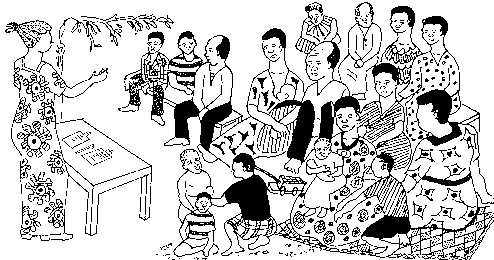Tweet
Translations:
'العربية / Al-ʿarabīyah
Bahasa Indonesia
Català
中文 / Zhōngwén
Deutsch
English
Español
Filipino/Tagalog
Français
Ελληνικά / Elliniká
हिन्दी / Hindī
Italiano
日本語 / Nihongo
Kiswahili
한국어 / Hangugeo
بهاس ملايو / Bahasa Melayu
Português
Română
Русский
Српски / Srpski
తెలుగు /Telugu
Tiếng Việt
Türkçe
Other formats:
Other Pages:
Modules
Site Map
Key Words
Contact
Utility Documents
Useful Links
Contents:
Contents:
Contents:
BRAINSTORMING;
PROCEDURES AND PROCESS
by Phil Bartle, PhD
Method Guidelines
A community empowerment training technique
These guidelines will help you to lead a group to making decisions by consensus. The technique can be used in a community meeting, in a meeting of the executive of a community based organization, among managers of an NGO, in a Governmental ministry or a UN agency management meeting, five to two hundred participants.
While you need good leadership qualities to conduct the session, and must be very firm in ensuring that the format and ground rules of the session are followed (eg no criticism or cross talk is allowed), you will be ensuring that the decisions are seen to be that of the group, not imposed upon them by yourself. You facilitate creative group decision making.
The Purpose of Brainstorming:
The purpose of a brainstorming session is to work as a group to define a problem, and find, through a participatory intervention, the best group decision for a plan of action to solve it.
Requirements:
- A problem to solve;
- A group with potential to work as a team. This works with a small management or operational team of five to ten people (eg trainers, field workers, a trade union), all the way up in size to a village meeting of a few hundred people;
- A board, large sheets of newsprint, or something that can be seen easily by all, and some large markers to write on it; and
- A facilitator (you). Someone who's task is to draw out the suggestions from the participants, not to impose her or his own opinions, while still using leadership skills to maintain the order and purpose of the session.
The Ground Rules:
- The facilitator leads each session;
- The facilitator calls for suggestions from the participants;
- No criticism (of anyone's suggestion) by anyone is allowed; and
- All suggestions should be recorded on the board (even the crazy ones).
The Procedure:
- Define the problem:
- Ask for suggestions as to what is the most important problem;
- No criticism (of anyone's suggestion) by anyone is allowed;
- Write all the suggested problems on the board;
- Group together any problems that are similar or related; then
- Rearrange them and list them in priority (most important ones at the top).
- Generate the Goal:
- Reverse the definition of the problem (it's solution);
- The solution to the problem defined above is the goal;
- Define the goal as the solution to the problem;
- Write the goal on the board; then
- Remind the group that the goal is the one that they selected.
- Define the Objective:
-
- Explain the difference between a goal and an objective;
- The facilitator should know this: (See SMART; an objective is measurable, finite, and has a completion date).
- Ask the group to suggest objectives;
- Write all the suggested objectives on the board;
- No criticism (of anyone's suggestion) by anyone is allowed;
- Group together any objectives that are similar or related;
- Rearrange them and list them in priority (most important at top); then
- Remind the group that they generated the top objective(s).
- Identify resources and constraints:
- Ask the group to suggest resources and constraints;
- Write all the suggested resources and constraints on the board;
- No criticism (of anyone's suggestion) by anyone is allowed;
- Group together any resources that are similar or related.
- Rearrange them and list them in priority (most important at top).
- Remind the group that they, not you, generated the list;
- Group together any constraints that are similar or related.
- Rearrange them and list them in priority (most important at top); then
- Remind the group that they generated the arrangement of the list.
- Identify a strategy:
- Ask the group to suggest strategies;
- Write all the suggested strategies on the board;
- No criticism (of anyone's suggestion) by anyone is allowed;
- Group together any strategies that are similar or related;
- Rearrange them and list them in priority (most important at top);
- Remind the group that they generated the list;
- Choose the strategy that remains at the top of the list.
- Summarize on the board the group decisions:
- the problem;
- the goal;
- the objectives;
- the resources;
- the constraints; and
- the strategy;
Conclusion:
It is simple. That does not mean it is easy. It improves with practice. You can intersperse the different phases of it with role playing, group games and other techniques of group work. Experiment with it and try different styles.
Good luck and successful mobilizing!
––»«––
The decisions in this example are based upon the four key questions of management. Together, the answers to these questions form the essence of project design. As an alternative, a SWOT session might be used for a larger group.
A Brainstorm Session:
 |